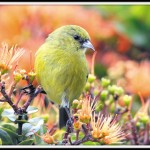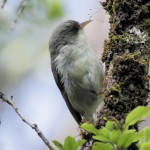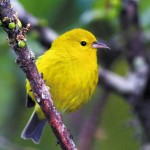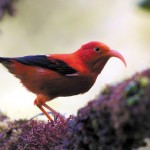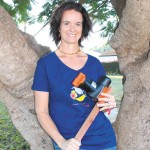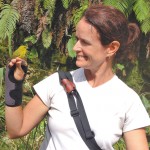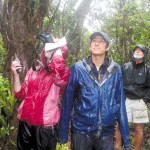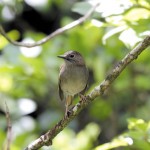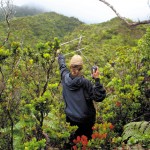For The Birds
Imagine no longer hearing the sweet melodies of Kauai’s native birds or missing out on their brilliant pops of red and yellow in Kokee State Park, as they bounce among ohia lehua. It would be a devastating loss, not only because of their value to the Hawaiian culture, but also their instrumental role in maintaining a healthy ecosystem — a role that groups such as Kauai Forest Bird Recovery Project (KFBRP) are only beginning to uncover and comprehend.
The endangered puaiohi, for example, is the only remaining bird that disperses seeds of native plants. Yet their numbers are fewer than 500. Only 11 of the some 130 indigenous Hawaiian bird species (many of which already are extinct), are not yet endangered, but even their numbers continue to drop. KFBRP is dedicated to protecting and restoring Kauai’s eight remaining native forest bird species, three of which are endangered and have suffered population drops of some 90 percent in the last five years — puaiohi (small Kauai thrush), akekee (Kauai akepa) and akikiki (Kauai creeper).
- Akekee
- Akikiki
- Anianiau
- Iiwi
- Lisa ‘Cali’ Crampton with a Goodnature trap that will help increase the population of native birds on Kauai by humanely eradicating rats. Coco Zickos photo
- With native Hawaiian forest birds such as the yellow anianiau in sharp decline — in large part because of predatory rats — Lisa Crampton and the Kauai Forest Bird Recovery Project are setting humane traps to lower the number of rats, in hope of saving these remarkable birds from extinction. Photo courtesy of KFBRP
- KFBRP representatives scout the forest for native birds
- Puaiohi
- One of KFBRP”s scientists, Kyle Pias, at work in the field using telemetry to study the habits of native forest birds
The main threats that the island’s birds face include habitat loss and introduced avian diseases carried by mosquitoes.
“Those can be pretty devastating,” says Lisa “Cali” Crampton, KFBRP’s project coordinator.
But the big problem KFBRP currently is working to reverse is predation — primarily by rats that feast on bird eggs and chicks, and they even have been known to attack nesting adult female birds. Rats also eat native vegetation and therefore destroy the birds’ homes and compete with them for food.
“Everywhere in conservation across Hawaii, people are trying to deal with rats,” notes Crampton.
To help fix the problem, the KFBRP created rat-proof nest boxes that protect birds like the puaiohi — which are especially vulnerable — from attacks.
The latest addition to the rat-eradication mission is the introduction of the revolutionary, humane Goodnature traps that already have proven to be a successful, cost-effective way of reducing the predator population.
How they work: The traps are humane because the rat’s death is instant. It smells bait (a scent is released) that it is attracted to, and when the rat crawls into the trap, it triggers the release of a piston that knocks the rat in the head. The rat falls to the ground, where it decomposes, and other rats are lured to the site because of the odor.
One of the many qualities Crampton appreciates about the traps is that they don’t have to be reset regularly and can be used some 20 times before requiring maintenance. Labor, especially in inaccessible environments like Alakai Wilderness Preserve, where the birds are located, is KRBRP’s biggest obstacle. The less labor needed, the better.
Because of the rat traps’ effectiveness, KFBRP, in conjunction with state Department of Land and Natural Resources, Division of Forestry and Wildlife, University of Hawaii Pacific Cooperative Studies Unit and Garden Island Research and Development Inc., have launched a campaign, “Birds, not Rats!” to help raise money to purchase additional contraptions.
“This project not only will benefit all the birds, it’s also going to benefit all the flowering plants and everything in that area,” says Crampton.
Crampton, who originally is from Victoria, British Columbia, has served in her current position almost five years. She has a biology degree from University of Victoria in Canada and achieved a Ph.D. from University of Nevada at Reno, where she focused her research on a local desert bird.
“I’m interested by how animals interact with the environment, and the interconnectedness of life — if you pull one piece out, other things can fall apart,” she explains.
During her postdoctoral studies, she worked with Laysan ducks on Hawaii island, where she fell in love with the Islands. She moved back to Nevada after her studies, but was happy when the job opportunity to work on Kauai came about.
“We thought it would be a really great place to raise a 2-year-old and a really challenging and fulfilling profession for me, and it has been all of those things,” says Crampton who, with husband Nassib Nabaa, an aerospace engineer, has a son, Cedric Crampton-Nabaa.
What Crampton enjoys most about her job is the ability to work with so many others who are on the same committed path to conservation. And it probably helps that she gets to spend so much time with some of the Garden Isle’s most precious and rarest creatures.
“They are just this little drop of lemon candy flitting through the trees,” she says about the anianiou, one of her favorite birds. “They’re just really cute.”
People can help save these birds by contributing to the campaign at indiegogo.com/projects/protect-hawaii-s-stunning-endangered-forest-birds until Saturday (Jan. 31).
“Individuals can make a huge difference, especially when they work collectively,” says Crampton.
Visit kauaiforestbirds.org for more information.
cocomidweek@gmail.com

